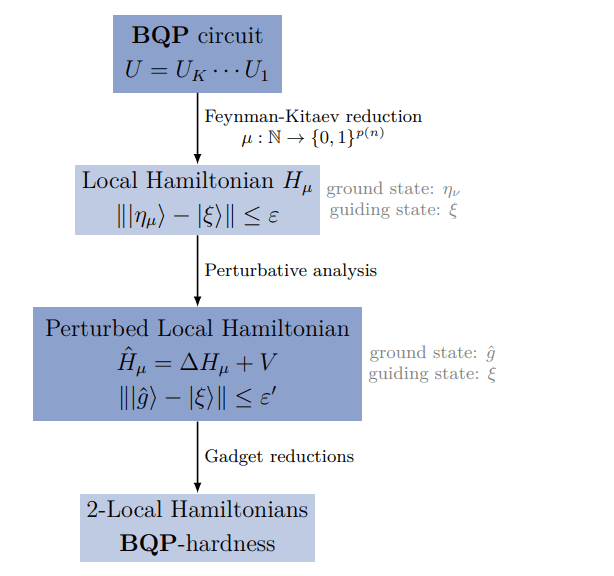The quest to understand the computational complexity of finding the lowest energy state of a physical system drives innovation in both quantum computing and materials science, and recent work by Gabriel Waite, Karl Lin, and Samuel J Elman, along with Michael J Bremner, all from the University of Technology Sydney, sheds new light on this challenging problem. The team investigates ‘guiding states’, simplified starting points for algorithms seeking ground states of complex Hamiltonians, and demonstrates that carefully chosen guiding states do not diminish the inherent difficulty of these problems for quantum computers. Importantly, they establish a constructive proof that a key problem remains computationally challenging even with these guiding states, while also showing that classical algorithms can still perform effectively under certain conditions. This research identifies a sweet spot for guiding states, balancing ease of preparation with computational power, and represents a significant step towards designing ground state estimation problems relevant to real-world experiments and clarifying the potential advantages of quantum approaches.
The research investigates how the choice of guiding states impacts the ability of these algorithms to find low-energy solutions to complex optimisation problems. Specifically, the team explores guiding states constructed from physically-motivated principles, aiming to improve the efficiency and accuracy of quantum optimisation. The investigation demonstrates that certain families of guiding states consistently outperform others, providing insights into the design of more effective variational quantum algorithms for tackling computationally challenging problems.
Researchers extend prior results concerning the difficulty of certain computational problems, moving beyond limited types of quantum states to consider states inspired by Quantum Chemistry and Hamiltonian Complexity. They demonstrate that broader families of states preserve the problem’s inherent difficulty while remaining computationally manageable under practical conditions. Crucially, the team provides a constructive proof confirming the problem’s containment within the complexity class BQP, establishing it as BQP-complete when a concise classical description of the guiding state is available. These results show quantum advantage persists for physically meaningful state classes, and classical methods remain viable when guiding states are appropriately defined.
Restricted Quantum States Amplify Computational Complexity
This research investigates the computational complexity of deciding whether certain families of quantum states can achieve low energy for a given local Hamiltonian. It moves beyond the standard k-Local Hamiltonian problem and focuses on problems where the search space is restricted to specific types of states, such as product states and Gaussian states. The goal is to understand how restricting the type of state affects the problem’s difficulty. The team demonstrates that restricting the search space to specific state types can significantly alter the complexity of the Local Hamiltonian problem. Restricting to product states does not simplify the problem; it remains NP-complete.
Similarly, the research demonstrates that even restricting to Gaussian states does not make the problem easier than the general k-Local Hamiltonian problem. This result relies on the fact that Gaussian states can represent basis states and are efficiently described classically. The team also proves that the energy of a Gaussian state for a k-local Hamiltonian can be computed efficiently classically, establishing the NP-completeness. The research introduces advanced semi-classical encoded subset states as a more general framework for exploring state types and potentially creating more complex computational landscapes. These states have efficient classical descriptions, allowing for sampling and query access, laying the groundwork for future investigation into the complexity of the Local Hamiltonian problem.
Guiding States Define Computational Complexity Boundaries
This research presents a detailed characterisation of guiding states within the Guided Local Hamiltonian problem, establishing new links between physical constraints and computational complexity. The team demonstrates that broader families of guiding states maintain the problem’s inherent computational hardness, while remaining amenable to classical computation under realistic parameter settings. Crucially, the researchers provide a constructive proof confirming the problem’s containment within the complexity class BQP, establishing it as BQP-complete when a concise classical description of the guiding state is available. The findings reveal a ‘Goldilocks zone’ of guiding states, those efficiently preparable, succinctly described, and accessible for sampling, enabling meaningful comparisons between quantum and classical approaches to solving the problem.
This work extends beyond theoretical considerations, identifying subclasses of guiding states that are both computationally complete and grounded in physically motivated contexts, such as those found in Quantum Chemistry and Hamiltonian Complexity. The research addresses a gap in prior work by pinpointing states with optimal guiding behaviour, specifically those maximising overlap with the true ground state while adhering to physical constraints. While the research notes that non-uniform amplitude distributions within guiding states can sometimes diminish their effectiveness, exceptions exist depending on the specific reduction employed, offering a potential avenue for future work.

